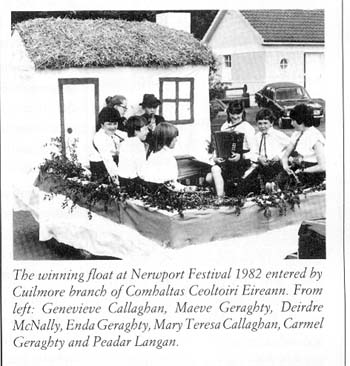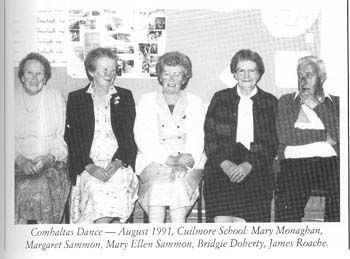

COMHALTAS Ceoltoiri Eireann (or "Comhaltas" as its known today) is an organisa- tion set up in 1951 to promote the playing of traditional Irish music, song and dance and also to revive the playing of the harp and pipes.
With the onset of country and pop music, it was feared that our native music was slowly dying, but thanks to that devoted body, our traditional music is very much alive today.
In 1979, Mary Langan brought a group of young children to Castlebar every Saturday to learn to play an instrument under the guidance of Martin Donoghue. A talented musician himself though handicapped from birth, he taught music on many instruments to children all over South Mayo and North Galway. Soon they were joined by many other children from the Newport area. Then it was realised that a branch of Comhaltas was needed and so the "Cuilmore Branch" was born. Most of the first junior members are in the senior category now, and more juniors are entering. John Hoban taught music at the school and now Marian McCaffrey (a native of Clare) is the present teacher.
Seisiuns and ceilidhe are run in the school to finance the branch. The pupils of Cuilmore branch have been winners of many medals at Feiseanna and Fleadhanna. Mairead Geraghty is the holder of an All-Ireland medal on the concertina, Peadar Langan on the pipes and Maeve Geraghty for whistling and lilting. On occasions the pupils travelled to Manchester, Scotland and Wales to perform at festivals.
 |
 |
Set Dancing is the order of the day at present. Classes and workshops on set dancing are being held in many community centres and halls through the country. Many different sets are being taught from the Derrada (Newport) to the Clare Lancers, from the Kerry Set to the Connamara and Paris Sets.
There is immense goodwill from the cultural aims of the Irish nation. An Comhaltas from its own experience knows this to be true at all levels. The voluntary cultural movement continues to thrive in every corner of Ireland and in many countries abroad. The membership continues to provide dedicated and efficient service. However, the voluntary movement no matter how successful is not an ultimate in itself; it is but a teacher and a motivator. In our culture, which is the cornerstone of our nationhood, is to be accorded a full and proper status then it must have the wholehearted protection and support of the State so that the whole community are exposed on a constant and attractive basis to their own culture.
The strong foundation of An Comhaltas at home and abroad is maintained through the several strong elements of the movement i.e. 400 branches; courses and workshops including the Diploma Course for traditional music teachers; Scoil Eigse; Annual Tours; Tionol Cheoil; National Entertainment Scheme; competitions; publications; records; tapes; tutors; Culturlann an hEireann, etc, etc. They are, however, ever- conscious of the huge potential which still remains for development, and they particularly look to the younger generation to take up the challenge which now faces our individuality as a nation. It is seldom they are found wanting when the right circumstances prevail.
An Comhaltas embraces people of all ages, creeds and politics. This does not entail neutralising or excluding those concepts but rather harmonising them in pursuit of a common goal. To this extent they have been very successful and the results achieved may be seen as a contribution towards lessening community tensions and strife and highlighting our common heritage rather than our differences.
As a member of Comhaltas one gets to meet many other musicians and make many friends. The comraderie between musicians is great, exchanging tunes and learning new ones.
Due to the formation of Comhaltas our lives have been enriched by the revival of our heritage.